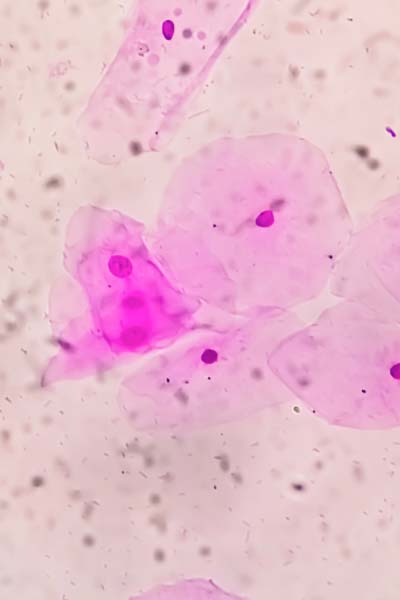
Are There Different Types of BV?
Published on Feb 12, 2024
Updated on July 14, 2025
Written by Kathleen Morrison
Medically Reviewed by Andrea Sleeth WHNP-BC, MSCP
BV is a complicated and mysterious topic. Is BV an STI or not? What actually causes BV? Do I have BV, or is it something else? If you’ve experienced unusual odor, discharge, burning, or itching down there, you know it can be hard to identify exactly what’s going on. The symptoms of BV, yeast infections, and STIs often overlap for people with vaginas, and we all know how hard it is to find reliable answers for your most specific questions. Let’s get into the nitty gritty of BV and separate fact from fiction.
What are the two types of BV?
When people discuss types of BV, they are often referring to a general irritation and inflammation of the vagina and vulva called vaginitis. Vaginitis, also called vulvovaginitis, is an umbrella term that refers to any inflammation or infection of the vagina. Symptoms like unusual vaginal discharge, itching or irritation, painful urination, and pain during intercourse can all be categorized as vaginitis. The two most common causes of vaginitis are yeast infections and BV, or bacterial vaginosis. Bacterial vaginosis can be triggered by different types of bacteria, but the most common one is Gardnerella.
What are the strains of BV?
Even the World Health Organization isn’t sure exactly what causes BV, but they do know that it occurs when there’s an overgrowth of certain families of pathogens: Gardnerella, Prevotella, Mobilincus, Megaspahera, Sneathea, and mixed vaginal anaerobes species. Gardnerella species are the most common, but when any of these species begin to multiply, they start replacing the beneficial Lactobacilli that help maintain a healthy vaginal environment. Lactobacilli are generally recognized as beneficial to the vaginal microbiome and help maintain healthy, balanced bacterial populations and a healthy pH. You may find this type of bacteria in many brands of probiotics, including Wisp’s!
What are the three grades of BV?
There are a few different ways to test for BV:
- Nucleic Acid Amplification Tests (NAATs): identify the specific bacteria causing issues.
- Hay/Ison Critera: using a special type of stain when examining the results of a vaginal swab and grading the sample appropriately.
- Amsel Critera: grading a number of different physical symptoms to diagnose BV.
The Hay/Ison criteria
- Grade 1 (Normal): Types of Lactobacillus dominate the swab, indicating a healthy result. If you have Grade 1, you are considered negative for BV.
- Grade 2 (Intermediate): Some Lactobacilli bacteria are present, but Gardnerella, Mobiluncus, or other mixed bacteria are also present. This is considered a negative result when evaluated in conjunction with the Amsel criteria, but if you have symptoms, you may benefit from BV treatment.
- Grade 3 (Bacterial Vaginosis): Predominantly Gardnerella and/or Mobiluncus bacteria are present, with very few or absent Lactobacilli. This is a definitive result and indicates you are positive for BV.
The Amsel criteria
- Thin, homogeneous vaginal discharge
- Clue cells on microscopic examination
- Elevated vaginal pH
- A positive whiff test with 10% Potassium Hydroxide
If you’ve had BV before, there’s often no need to take a test. You’ll likely have the same symptoms if you get it again and you’ll be able to recognize them. If you’ve never had BV before, it may be harder for you to tell the difference and it’s easy to get BV symptoms mixed up with STI or yeast symptoms. It may be best to visit your OBGYN or urgent care to take a test in person to ensure the treatment you get will be effective.
What can BV be mistaken for?
Most vaginal infections have very similar symptoms: unusual fishy odor, green or gray discharge, itching, soreness, pelvic pain, and burning with urination can be indicative of any number of vaginal infections, including yeast infections and STIs. There are two main ways to tell the difference between BV and a yeast infection:
- Discharge: BV discharge will appear to be very thin and is often either greenish or grayish in color. Discharge as a result of a yeast infection is often white and chunky—some people describe it as “cottage cheese-like.”
- Odor: BV usually has a strong, distinctive fishy odor. Yeast infections are more likely to be odorless, or may smell mildly yeasty or bready.
STIs and BV are also often confused with one another. It’s much more difficult to tell them apart, especially if you’ve never had BV before. There are two STIs in particular that may present a lot like BV: Mycoplasma Hominis (M. Hominis) and Ureaplasma Urealyticum (Ureaplasma). These two types of bacteria can exist in healthy genital tracts in people of all genders, but much like BV, they can cause problems if they begin to grow out of control. Both types of bacteria can cause pelvic or abdominal pain, urethritis, prostatitis, vaginal discharge, odor, and itching, and trouble getting pregnant. To get the correct treatment, it’s important to get tested if you are experiencing any of these symptoms, if you believe you’ve been exposed by a sexual partner, or if you have recurrent BV symptoms that don’t seem to be resolving with your typical antibiotic treatment. Wisp can provide you with a lab slip to a lab of your choosing and the appropriate prescription treatment once your test identifies what type of care you need!
How can I treat symptoms of BV?
It's always best to treat the root cause of any vaginal symptoms, rather than just treating the symptoms themselves. While you may feel better in the short term, only treating your symptoms will lead to them coming back over and over, and can have long term impacts on your overall health and wellbeing. Seek out care from a medical provider for any prescription medicine you may need to address yeast, BV, or STIs. Prescription antifungals and antibiotics can often take a day or two to kick in, so you can also use a topical treatment like Wisp's Calm Down! Instant Itch Relief for Yeast and BV to soothe symptoms instantly. Our custom compounded formula is created using Hydrocortisione and Lidocaine for ultimate itch and pain relief—even in your most sensitive areas.
BV can be tricky to identify on your own—let the professionals help! Consult with a Wisp provider online to get the treatment you need and start feeling better fast.
Get BV Medication Online

BV Antibiotics (Tablets or Gel)
Starting at $15
Request topical or oral prescription antibiotics to treat bacterial vaginosis.

Metronidazole Gel (Metrogel)
Starting at $90
Prescription vaginal cream to treat new or chronic BV infections from home.

Calm Down! Instant Itch Relief for BV & Yeast
$36
Prescription cream used to relieve uncomfortable symptoms of BV and Yeast.

Vaginitis Test
$159
Test for the 10 most common disruptive microbes from the comfort of home with one swab.


